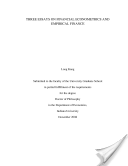Three Essays on Financial Econometrics and Empirical Finance
The first essay applies a copula-GARCH class of models to capture the joint distribution of excess returns for four major asset classes: one-year and ten-year Treasury bonds, S&P 500, and Nasdaq index. Three approaches are attempted in building the multivariate copula for the dependence structure of multiple assets: (1) n-dimensional normal copula and n-dimensional Student-t copula, (2) hierarchical Archimedean copula, and (3) mixed copula. Our Student-t copula augmented by a time-varying covariate structure yields the highest log-likelihood and generates dependence patterns that are most consistent with the empirical data. The second essay solves the asset allocation problem for investors facing the choice between a risk-free bond, a passively managed index fund, and an actively managed fund. Asset allocation is based on a Bayesian copula-GARCH model. We apply this model to the "passive funds versus active funds" problem with three alternative asset categories - "large cap" fund, "small cap" fund, and international stock fund - and test our model's performance in an out of sample. We demonstrate that risk-averse investors should allocate a significant fraction of their wealth to actively managed funds for all three of the considered actively managed fund categories. Moreover, the Bayesian model suggests that risk-averse investors should assign a more conservative weight to the actively managed fund, which results in significantly less volatile out-of-sample returns and the realized investors' utilities. The third essay conducts an empirical investigation of significance of the liquidity and information risks in explaining the dynamics of corporate yield spreads. Our analysis is based on a sample of 17 bonds from TRACE database, eleven of which are of investment grade type and six of which have non-investment grade type. We use the number of trades (NOT), trade volume, and the trade impact on bond price (ILLQ) to characterize the illiquidity risk, and use several alternative asymmetric information measures (AIMs) to capture the information risk. The selected illiquidity and information risk factors play an important role in explaining cross-sectional and intertemporal variation of yield spreads for the selected bonds, being especially successful in explaining intertemporal variation of yield spreads for non-investment grade bonds.
Robert A. Meyers, Robert A. Meyers, Robert A. Meyers
Anil K. Bera, Sergey Ivliev, Fabrizio Lillo, Anil K. Bera, Sergey Ivliev, Fabrizio Lillo

